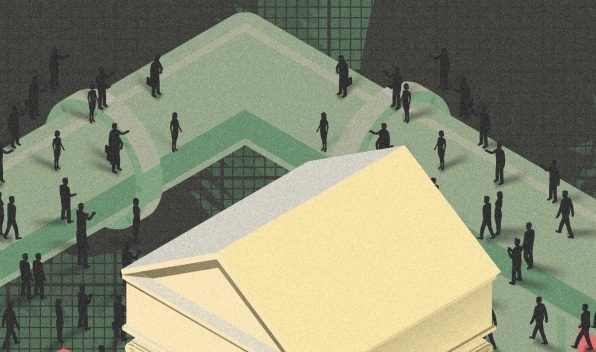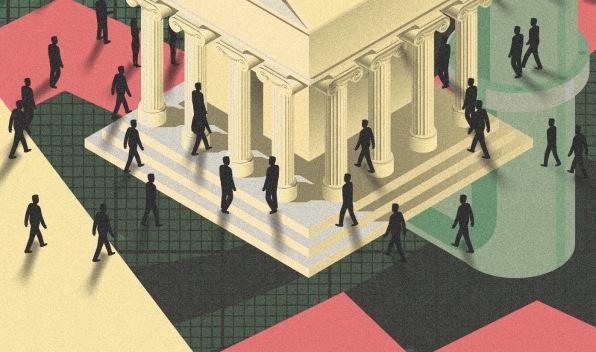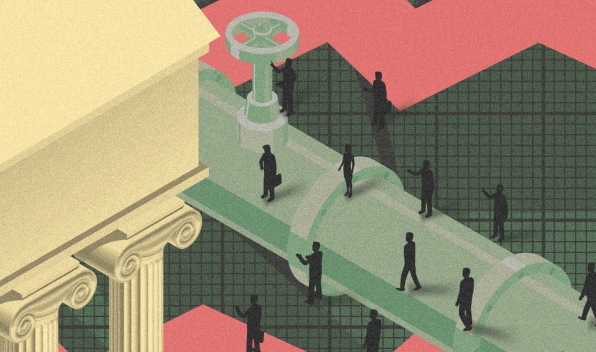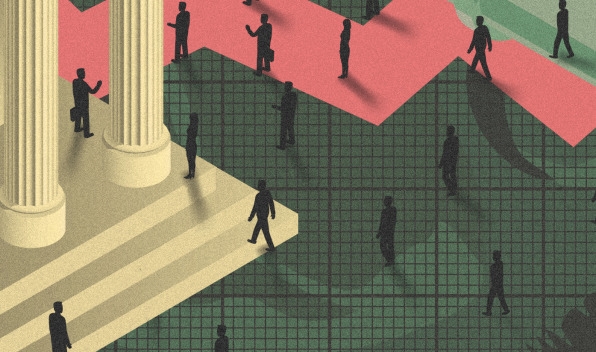For the latter half of 2016, the Standing Rock Sioux and activist allies from all over the country camped out in North Dakota to protest the construction of the Dakota Access Pipeline, which was likely to harm their native lands through an invasive engineering process and inevitable oil spills.
And at the same time, the hashtag used to protest the pipeline, #NODAPL, started appearing scrawled over Wells Fargo billboards across the country.
Wells Fargo was one of around 15 banks that directly invested in the pipeline, and in drawing the connection between the bank and that controversial project, activists began to call attention to just how broad and diverse the banks’ reach was. Cities like Seattle, San Francisco, Los Angeles, and Albuquerque use Wells Fargo to hold their finances–everything from taxes to parking meter dollars. Activists in all those cities, and more, began to call on their local governments to divest from Wells Fargo, and pull their money from the bank.
“But the question was: If we pull money out of Wells Fargo, where would it go?” says Ellen Brown, the chair of the Public Banking Institute, a research nonprofit formed in 2011 to further the conversation around alternatives to the current banking system in the U.S. Large, private banks are so intertwined with the way American government operates that divesting from that system is not a simple task. It wasn’t enough for a city to just pull its money from Wells Fargo and drop it in another bank. (Seattle even attempted to do that and, unable to find another bank that would hold its money, ultimately renewed its contract with Wells to the chagrin of activists.)
Instead, organizers began to rally around the idea of a different type of financial institution: public banks. As the name implies, they are publicly owned, often by cities, and accountable to the people who live there, not their shareholders. Big private banks like Wells Fargo tend to invest the money they hold in immediately profitable ventures, like securities trading and yes, oil projects, because the people who own stock in the banks demand large returns. In contrast, public banks are owned by the government, and their primary obligation is to support constituents. They can do this through making low-interest loans to small businesses or to necessary infrastructure projects. In the past several years, public banking has gone from a fringe idea, buoyed by the controversy around DAPL, to a viable policy route that cities from San Francisco to Washington, D.C., are considering. And cementing its place in the public discourse, public banking was citied in the text of the Green New Deal resolution drafted in February by Representative Alexandria Ocasio-Cortez (D-NY) and Senator Ed Markey (D-MA).
This story is part of our series A Green New Deal for Business, looking at how the environmental and economic aims of the resolution might transform industries in the U.S. You can read more here.

What is a public bank?
In contrast to the big, privately owned banks in the U.S., public banks are owned by government entities; theoretically, they could operate at the city, state, or federal level. They’re funded with revenue from constituent taxes or from the federal government, and as such, are intended to be accountable to public interest and demands, as opposed to big private banks, which are beholden to shareholders. “In a million cases where a bank officer has to choose between advancing the private profit of the bank versus what is good for [the social aims] banking is supposed to serve, these officers follow the idea that the bottom line of the bank is their first concern,” says Richard Wolff, professor of economics at the New School.
Public banks can be set up by a government to hold government deposits. But before they can begin doing that, they would need some initial startup capital, which they could generate through public bond sales, crowdfunding, or a long-term loan from the Federal Reserve. Once the public bank is set up, it can loan capital to local projects. This is where the difference between public banks and private banks really becomes apparent. A report from the environmental justice organization Demos describes how big banks are less likely to make loans to small businesses or projects like affordable housing construction, which might not generate strong enough financial terms to merit the cost of underwriting a loan. And for the loans they do make, they charge steep interest—often in the double-digit percents—to ensure they take in a profit. This high-interest lending applies to cities that borrow for public projects, too. A now-notorious example of this is the new span of the Bay Bridge between Oakland and San Francisco. The project cost around $6.4 billion to complete, but because the California Department of Transportation took out loans from Wall Street banks and private investors to pay for it, the state agency ultimately had to cough up around $13 billion—double the cost—to account for interest. The same load of interest payments is also crippling the state’s attempt to build a high-speed rail corridor (which is something the Green New Deal specifically calls for).
Public banks, in contrast, can lend at very low interest rates because they’re trying to keep their capital consistent, not make a profit. Furthermore, the interest that they do charge ultimately comes right back into the same, publicly owned banking mechanism, so it can be loaned out again to local projects or to community banks that serve residents. Essentially, it’s a way to circulate financial resources through an economy in a way that’s responsive to local needs. Furthermore, public banks managed by a government, which would have to come up with a charter for how the bank functions and who it’s responsible to. The charter could put a cap on executive pay, for instance (Jamie Dimon, CEO of JPMorgan, takes home over $31 million each year), and designate that its investments should prioritize agreed-upon aims, transportation access, affordable housing, or clean energy projects.
The model is not without precedent in the U.S. Last year, American Samoa created a public bank, and the Bank of North Dakota was established in 1919. State tax dollars are deposited into the bank, which was set up to help farmers get access to credit when they were denied by private institutions. Now, BND works in tandem with other financial institutions in the state, like credit unions, by seeding them capital to help them make loans to local businesses and initiatives (in part because of BND, North Dakota has more credit unions and local financial institutions per capita than any other state). Because BND is publicly owned, it does so at much lower interest rates (in contrast to Dimon, BND CEO Eric Hardmeyer takes home an annual salary of around $250,000). Demos reports that because of BND, North Dakota has more loans to local banks and small businesses per capita than any other state. It also makes student loans at some of the lowest interest rates in the country.
Interest in BND has spiked in part because of how the bank performed during the financial crisis of 2008. In 2014, a report found that BND was more profitable than Goldman Sachs and had a better credit rating than J.P. Morgan Chase, in large part because of its public ownership model. It’s worth noting, though, that BND does make loans to profitable state industries like oil, which many public banking advocates in other states would protest. This illustrates, however, how a public bank responds to local interests: Support for the oil industry is high in North Dakota, but elsewhere, a publicly agreed-upon charter for a bank could direct its investments elsewhere.

Why does public banking belong in the Green New Deal?
Public banking’s appearance in the Green New Deal resolution drafted by Ocasio-Cortez and Markey in February further cemented its potential as a tool to create a more stable and just economy—and one that can center concerns of the public, like environmental matters, in its operations. The success of a Green New Deal, Ocasio-Cortez and Markey wrote, will require:
Providing and leveraging, in a way that ensures that the public receives appropriate ownership stakes and returns on investment, adequate capital (including through community grants, public banks, and other public financing), technical expertise, supporting policies, and other forms of assistance to communities, organizations, federal, state, and local government agencies, and businesses working on the Green New Deal mobilization.
The Green New Deal calls for an aggressive decarbonization of the economy through investment in green infrastructure, innovation, and overall systems change coupled with equity aims including access to education, work opportunities, and affordable housing for all. And one of the concerns that’s attached to the proposal is how to pay for it. Estimates put the total cost of the sweeping proposal at over $12 trillion. Both levying a carbon tax (and potentially others on wealth and inheritance) and rolling back existing fossil fuel subsidies could free up funds.
But in order for this revenue to flow efficiently toward funding projects under the Green New Deal (for example: a high-speed rail network, or a revamped energy grid to accommodate an influx of wind and solar), it would need publicly responsive and flexible system to manage it. Brown has studied this extensively. She points to the fact that Franklin Delano Roosevelt’s New Deal (the obvious antecedent to the Green New Deal) was financed largely by the Reconstruction Finance Corporation, a publicly owned credit-lending agency, which backed thousands of projects ranging from national infrastructure to small-business enterprises.
The New Deal was transformative for both the economy and the infrastructure of the United States, and its scale is one that the Green New Deal aims to emulate and surpass, with the added layer of urgency due to climate change. And “it would be very difficult to come up for the money for a Green New Deal without a public banking system,” Brown says.
So many of the initiatives the Green New Deal resolution calls for—from radically expanded public transportation, to affordable housing, to local efforts to boost access to clean energy—are, quite simply, things that would struggle to attract mainstream capital from big banks. Or if they could, California’s debt-riddled infrastructure projects show that they could sink cities and states into financial holes. Brown believes that a robust network of public banks could unlock the low-interest capital needed to fund these diverse projects at the state, local, and federal levels. And it could do so in a way that keeps the money flowing through those economies, instead of up and away toward private shareholders and executives.

How would a public bank help decarbonize the economy?
In an economy shaped by the principles of the Green New Deal, a network of publicly owned banks would make loans to governments and the private sector alike to finance decarbonization efforts, including carbon-neutral manufacturing and clean energy initiatives. People could help shape how public banks invest funds through a participatory process to draw up the bank’s charter. For cities and states, public banks present an opportunity to avoid the high interest fees on loans that big banks impose. Consequently, they could pursue more projects, like public transportation and affordable housing, that benefit people in their backyards.
A public banking system in the U.S. to support decarbonization efforts could function as a network. A national public bank could access initial capital from the federal government, and make loans to state banks, which in turn offer funding to a network of local institutions, much like North Dakota already does. “We need to harness the power of the Federal Reserve to do something other than bail out big private banks,” Brown says. It’s well within the entity’s capability to seed large amounts of capital, and it could provide the backing to a potential network of public banks via a central, public finance institution like the Reconstruction Finance Corporation (Brown has been advocating for the use of a public bank for the U.S. since the recession in 2008).
This would not, Brown says, mean that the existing big, private banks like Wells Fargo and J.P. Morgan would go away entirely; they play an important role in international trade. Rather, their role would be diminished, particularly for the purposes of financing public projects. Wolff believes they could be nationalized and brought under the control the federal government, as was proposed but ultimately not carried through after the 2008 financial crisis, and as was done in Europe after the Great Depression. Furthermore, public banking institutions, Wolff says, could present an opportunity to change up their governance structures: Rather than a hierarchical leadership model, decision making for banks at every level could be carried out by a diverse board of representatives comprising public and private sectors, and, especially in the context of the Green New Deal, the interests of the environmental and equity movements.

Where is public banking taking root already?
Currently, activists in San Francisco, New York, D.C., Los Angeles, and more are agitating for a public bank at the local level. In California, the Assembly and the Senate are advancing a set of bills that would ease the process for creating a state public bank and allow cities to establish charters for their own public banks. This, says Kurtis Wu, an organizer with the public banking movement in San Francisco, is a confirmation that the work they’ve been doing to encourage their city to move to a more publicly beneficial banking mechanism could actually take root.
In New York City, the public banking movement predated the inclusion of the concept in the Green New Deal resolution. Organized by a broad coalition including the New Economy Project, which advocates for equality and environmental justice in the city, and the New York Public Interest Research Group, which runs campaigns and research projects around issues of environmental sustainability and justice, the Public Bank NYC coalition believes a public bank could help drive investments in affordable housing, locally controlled clean energy, and more cooperatively owned businesses. These aims all track with what the GND calls for, but according to Andy Morrison of the New Economy Project and Tousif Ahsan of NYPIRG, these needs have been long evident in New York City, and the push for public banking in the city has more to do with addressing those needs than complying with the policy.
Which is a point of proof that Markey and Ocasio-Cortez want the Green New Deal to find a foothold in the U.S. by responding to needs that communities have already called for. In calling for public banking, they’re recognizing pre-existing momentum and elevating it to part of a national proposal.
In most cities where activists are agitating for a public bank, the push has originated with local organizers. But in Washington, D.C., the idea for a public “green bank” to finance environmental justice projects actually originated with the council, says Johanna Bozuwa, a research associate at the Democracy Collaborative who focuses on clean energy transitions. “The Green Bank came into existence when the Department of Energy and Environment in D.C. put together a proposal, then 350 DC, the volunteer organizing group that does a lot around climate justice in the district got a hold of the proposal and were really excited about the potential,” she adds.
The proposed green bank would not fully replace D.C.’s banking system, but would create a mechanism for investing public and private money in green infrastructure projects. It’s not quite as radical as the idea of creating a local public bank for a city’s entire financial operations, but it does nod to the fact that public financing for clean energy transitions is a commonsense enough model to originate from within a city government. Organizers with 350 DC, according to Ntebo Mokuena, who is one of them, are working closely with the council to make sure that the green public bank, when established, targets its financing to support clean energy projects that also reach equity aims, like connecting low-income families to solar and affordable retrofits.
The changes that a proposal like the Green New Deal calls for are not small, even though they are gaining broad public support in many cities. The thing that often gives government officials and citizens pause, though, is how they could possibly be implemented in a financially feasible way. The push for public banking shows that perhaps, the question is not how much money is required, but rather, if the existing financial system in the U.S. is the best and most efficient mechanism through which to funnel the necessary financial resources. Organizers and movement leaders like Brown suggest that it’s not, and a network of banks that are beholden to the public and to larger equity and environmental aims, rather than private shareholders and executives, could be the key to getting the wheels turning on the Green New Deal.
(57)